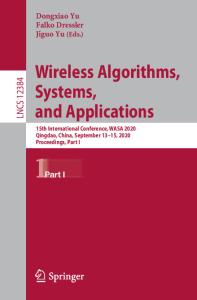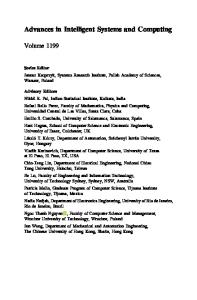A Cuckoo Search Algorithm-Based Task Scheduling in Cloud Computing
Recently, Cloud computing emerges out as a latest technology which enables an organization to use the computing resources like hardware, applications, and software, etc., to perform the computation over the internet. Cloud computing gain so much attention
- PDF / 203,168 Bytes
- 7 Pages / 439.37 x 666.142 pts Page_size
- 10 Downloads / 349 Views
Abstract Recently, Cloud computing emerges out as a latest technology which enables an organization to use the computing resources like hardware, applications, and software, etc., to perform the computation over the internet. Cloud computing gain so much attention because of advance technology, availability, and cost reduction. Task scheduling in cloud computing emerges out as new area of research which attracts the attention of lots researchers. An effective task scheduling is always required for optimum or efficient utilization of the computing resources to avoid the situation of over or under-utilization of such resources. Through this paper, we are going to proposed the cuckoo search-based task scheduling approach which helps in distributing the tasks efficiently among the available virtual machines (VM’s) and also keeps the overall response time (QoS) minimum. This algorithm assigns the tasks among the virtual machines on the basis of their processing power, i.e., million instructions per seconds (MIPS) and length of the tasks. A comparison of cuckoo search algorithm is done with the first—in first—out (FIFO) and greedy-based scheduling algorithm which is performed using the CloudSim simulator, the results clearly shows that cuckoo search outperforms the other algorithms.
⋅
Keywords Virtual machines Cloud computing Cuckoo search Genetic algorithm Makespan
⋅
⋅
⋅
QoS
⋅
Task scheduling
⋅
M. Agarwal (✉) ⋅ G.M.S. Srivastava Department of Physics & Computer Science, Dayalbagh Educational Institute, Agra, India e-mail: [email protected] G.M.S. Srivastava e-mail: [email protected] © Springer Nature Singapore Pte Ltd. 2018 S.K. Bhatia et al. (eds.), Advances in Computer and Computational Sciences, Advances in Intelligent Systems and Computing 554, https://doi.org/10.1007/978-981-10-3773-3_29
293
294
M. Agarwal and G.M.S. Srivastava
1 Introduction Exponential growth in the accessibility of internet and its based technologies, Cloud Computing emerges out as a new form of computing paradigm which becomes very much popular in both industry and academia in short duration of time [1, 2]. As cloud is a collection of the large number of computing resources like processing unit, storage units, and networking components, etc., to service the user. Cloud computing has the features of grid computing, distributed computing, and utility computing [2] but it differs from them as it uses the concept of virtualization for the resource management [3]. Some important features which attract the users and businesses to migrate to the cloud-based technology are: scalability, economic in use, rapid elasticity, on demand accessibility of the resources, and its ubiquitous property [4, 5]. In cloud computing, users do not have to bother about the location of services, i.e., where the resources are located, but the only need is the internet access to fulfill their demands as the resources are available across the globe over the internet. The user needs to use the resources and pay as and when used [6]. Scheduling refers to the
Data Loading...











